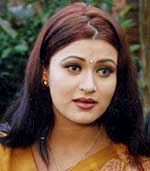 Even as the scandal caused by Shrisha Karki's suicide has all but petered out in the face of bigger political issues in Nepal, the untimely death of an aspiring young woman must not go in vain. Her suicide ought to provide a site for Nepali civil society to ponder the agency of Nepali women caught between the contradictory messages of patriarchal tradition and consumerist modernity.
Even as the scandal caused by Shrisha Karki's suicide has all but petered out in the face of bigger political issues in Nepal, the untimely death of an aspiring young woman must not go in vain. Her suicide ought to provide a site for Nepali civil society to ponder the agency of Nepali women caught between the contradictory messages of patriarchal tradition and consumerist modernity. We need to ask some difficult questions about Nepali urban society, where contradictory desires and aspirations clash with directionless public institutions and cultures. Seen this way, Shrisha Karki's death provides a window to the hypocrisy, corruption, and pretensions of many Nepali urban inhabitants, whose ideological resources, both feudal and modern, have seldom received feedback from a tradition of rigorous critical interpretation.

Shrisha Karki's so-called nude picture in Janastha weekly speaks of matters that go beyond her suicide. It speaks of the professional illiteracy of many Nepali journalists, their lack of systematic education and training in the skills, values and ethics of their profession. More disturbingly, it also speaks of the significant blindness toward sexuality issues in the party line left, whose activist Janastha's editor has been made out to be in the media.
Not the least, it represents the moral confusion of many up and coming urban Nepali women-their desire for freedom but unwillingness to stand up and fight for their rights, their enthusiasm to participate in consumerist culture but lack of knowledge and courage to redefine their body and sexuality. It shows they cannot be free while still harbouring traditional notions of shame, honour, body, and a woman's place in family and society. Above all, it exposes the brutal and inhuman side of Nepali mainstream culture, which is still run by high caste Hindu patriarchal ideologies.
When I look at the Janastha picture, I can't help but ask myself: What depth of illiteracy and insensitivity made the journalists and their editor permit the title "The Colourful Night of Filmdom" go with Shrisha's heart-rending picture? In fact, the scandal would have been about something else altogether: how even educated middle class Nepali women find themselves helpless in their capital at the hands of the powerful. For cultural critics, the nude photo ought to be known, studied, and interpreted as a classic text of Nepali women's cumulative oppression under Hindu patriarchy at the crossroads of tradition and modernity.
Anyone can read the mark of duress written all over the picture-the mascara-laced terror-stricken eyes, permed but disheveled hair, the mouth half agape in scream, the chilling naked body hunched over folded knees, struggling to hide shame. Anyone can see that it's not the picture of a nude at all but a naked picture of a woman taken under extreme duress. This is a classic case of centuries of Hindu women's oppression under patriarchy, not just the work of a bunch of Nepal's rogues with male or female genitalia.
Does the Janastha journalists' thinking reflect even in miniscule the attitude of Nepal's male-dominated media? Their inability to read beyond the surface of cultural texts, their public righteousness about political democracy but private blindness toward cultural democracy? What qualifies them to call themselves journalists? The mere ability to run tabloids and write trash? And when one hears that such journalists served the cause of the left in Nepal and uncovered some serious scandals of the powerful in the past, one's blood runs cold. Can personal aggrandizement supersede basic professional obligations and human decency? Whether what Kishor Shrestha did amounts to criminal misconduct is for the legal institutions to decide, but this failure is indicative not just of the
dirty underside of Nepali journalism but also its structural deficiency. One can excuse the democratic illiteracy and blindness of a nominated bureaucrat in a semi-feudal social structure, but how can one understand suicidal error in a noted leftist journalist?
In the sudden razzle-dazzle of global consumerism often disguised as middle class purchasing power and democratic freedom, Shrisha might have confused the thin yet deep line between commerce and desire. Still, she deserves dignity and is entitled to her rights. The terrified and terrifying picture ought to have elicited just the opposite response from the Janastha gang. It doesn't portray a "Colourful Night". It offers a troubling glimpse of Nepali male culture of the powerful.
If Shrisha Karki is to blame for anything, it is for her suicide. She endorsed all the values of patriarchy-traditional notions of honour and shame associated with a woman's body and sexuality. If she had been coerced into nudity, she ought to have raised hell in the media or with the law. But she succumbed to the tradition of honour and shame.
As a result, she became one of the countless victims of Hindu patriarchy rather than a soldier of change in the status of Nepali women. If Nepali women are to achieve equality it is by standing up for their actions and asserting their rights to be who they are and who they want to be. If a Nepali man can brag about his prostitution, why can't a woman acknowledge or deny her errors honestly and move on with her life-and, yes, fight for her right to be nude by choice and against forced nakedness or forced anything?
(Pramod K Mishra teaches English at Augustana College, Illinois, in the United States.)


